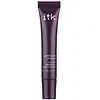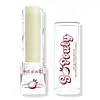What's inside
What's inside
 Key Ingredients
Key Ingredients

 Benefits
Benefits

 Concerns
Concerns

 Ingredients Side-by-side
Ingredients Side-by-side

Polybutene
Hydrogenated Polyisobutene
EmollientDiisostearyl Malate
EmollientMicrocrystalline Wax
Emulsion StabilisingSynthetic Wax
AbrasivePolyglyceryl-2 Triisostearate
EmulsifyingHydrogenated Styrene/Isoprene Copolymer
Triacontanyl Pvp
HumectantButyrospermum Parkii Butter
Skin ConditioningTheobroma Cacao Seed Butter
EmollientEuphorbia Cerifera Wax
Cocos Nucifera Oil
MaskingCopernicia Cerifera Wax
Glyceryl Caprylate
EmollientTocopheryl Acetate
AntioxidantPolybutene, Hydrogenated Polyisobutene, Diisostearyl Malate, Microcrystalline Wax, Synthetic Wax, Polyglyceryl-2 Triisostearate, Hydrogenated Styrene/Isoprene Copolymer, Triacontanyl Pvp, Butyrospermum Parkii Butter, Theobroma Cacao Seed Butter, Euphorbia Cerifera Wax, Cocos Nucifera Oil, Copernicia Cerifera Wax, Glyceryl Caprylate, Tocopheryl Acetate
Polybutene
Hydrogenated Polyisobutene
EmollientMicrocrystalline Wax
Emulsion StabilisingSynthetic Beeswax
Emulsion StabilisingCopernicia Cerifera Wax
Sucrose Tetrastearate Triacetate
EmollientAroma
Euphorbia Cerifera Wax
Synthetic Wax
AbrasivePhenoxyethanol
PreservativeDiisostearyl Malate
EmollientPentaerythrityl Tetra-Di-T-Butyl Hydroxyhydrocinnamate
AntioxidantCocoyl Hydrolyzed Collagen
CleansingSilica Dimethyl Silylate
EmollientHydrolyzed Hyaluronic Acid
HumectantGlycerin
HumectantFragaria Ananassa Fruit Extract
Skin ConditioningLeuconostoc/Radish Root Ferment Filtrate
AntimicrobialCI 45410
Cosmetic ColorantCI 77891
Cosmetic ColorantCI 15850
Cosmetic ColorantCI 19140
Cosmetic ColorantPolybutene, Hydrogenated Polyisobutene, Microcrystalline Wax, Synthetic Beeswax, Copernicia Cerifera Wax, Sucrose Tetrastearate Triacetate, Aroma, Euphorbia Cerifera Wax, Synthetic Wax, Phenoxyethanol, Diisostearyl Malate, Pentaerythrityl Tetra-Di-T-Butyl Hydroxyhydrocinnamate, Cocoyl Hydrolyzed Collagen, Silica Dimethyl Silylate, Hydrolyzed Hyaluronic Acid, Glycerin, Fragaria Ananassa Fruit Extract, Leuconostoc/Radish Root Ferment Filtrate, CI 45410, CI 77891, CI 15850, CI 19140
Ingredients Explained
These ingredients are found in both products.
Ingredients higher up in an ingredient list are typically present in a larger amount.
Copernicia Cerifera Wax comes from a palm tree native to Brazil; another name for this ingredient is Carnauba Wax.
This ingredient is used to thicken texture and also leaves behind a film when applied.
Fun fact: This wax has the highest melting point of all natural waxes and low solubility.
Learn more about Copernicia Cerifera WaxDiisostearyl Malate is an emollient and most often used in lip products. It comes from isostearyl alcohol, a fatty acid, and malic acid, an AHA.
As an emollient, Diisostearyl Malate helps create a thin film on your skin to trap moisture in. This helps keep your skin soft and smooth.
Hydrogenated Polyisobutene is a synthetic polymer. Polymers are compounds with high molecular weight. Hydrogenated Polyisobutene is an emollient and texture enhancer.
In one study, Hydrogenated Polyisobutene showed better skin hydration levels than Caprylic/Capric Triglyceride. As an emollient, it helps keep your skin soft and hydrated by trapping moisture in.
Hydrogenated Polyisobutene is often used as a mineral oil replacement.
Learn more about Hydrogenated PolyisobuteneMicrocrystalline Wax is created by de-oiling petroleum. It is highly refined and purified before being added to cosmetics.
Microcrystalline Wax is used to enhance the texture and create even consistency. It helps stabilize a product by preventing ingredients from separating.
Polybutene is used to help control the viscosity of a product. This just means it helps adjusts the texture.
It is a polymer and does not get absorbed into the skin due to its large size.
Studies found this ingredient did not irritate skin in concentrations below 15%.
Learn more about PolybuteneSynthetic Wax is created from fossil fuels such as natural gas. It is used to enhance texture, adjust pH, and as an occlusive.
It may also be used as an abrasive ingredient to exfoliate the skin.
Synthetic Wax may not be fungal acne safe.
Learn more about Synthetic WaxEuphorbia Cerifera wax comes from a shrub in Northern Mexico. It is used to stabilize formulations and has emollient properties.
Emollients form a thin layer on top of skin to prevent water from evaporating, keeping skin and lips hydrated.
According to a manufacturer, this wax can range from a yellow/brown color to translucent.
Learn more about Euphorbia Cerifera Wax